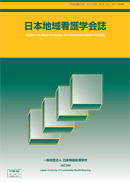Volume 7, Issue 1
Displaying 1-12 of 12 articles from this issue
- |<
- <
- 1
- >
- >|
-
Article type: Article
2004Volume 7Issue 1 Pages 16-22
Published: September 30, 2004
Released on J-STAGE: April 20, 2017
Download PDF (1377K) -
Article type: Article
2004Volume 7Issue 1 Pages 23-28
Published: September 30, 2004
Released on J-STAGE: April 20, 2017
Download PDF (907K) -
Article type: Article
2004Volume 7Issue 1 Pages 29-34
Published: September 30, 2004
Released on J-STAGE: April 20, 2017
Download PDF (1019K) -
Article type: Article
2004Volume 7Issue 1 Pages 35-40
Published: September 30, 2004
Released on J-STAGE: April 20, 2017
Download PDF (915K) -
Article type: Article
2004Volume 7Issue 1 Pages 41-48
Published: September 30, 2004
Released on J-STAGE: April 20, 2017
Download PDF (1164K) -
Article type: Article
2004Volume 7Issue 1 Pages 49-54
Published: September 30, 2004
Released on J-STAGE: April 20, 2017
Download PDF (887K) -
Article type: Article
2004Volume 7Issue 1 Pages 55-61
Published: September 30, 2004
Released on J-STAGE: April 20, 2017
Download PDF (1157K) -
Article type: Article
2004Volume 7Issue 1 Pages 62-67
Published: September 30, 2004
Released on J-STAGE: April 20, 2017
Download PDF (951K) -
Article type: Article
2004Volume 7Issue 1 Pages 68-74
Published: September 30, 2004
Released on J-STAGE: April 20, 2017
Download PDF (1151K) -
Article type: Article
2004Volume 7Issue 1 Pages 75-80
Published: September 30, 2004
Released on J-STAGE: April 20, 2017
Download PDF (948K) -
Article type: Article
2004Volume 7Issue 1 Pages 81-87
Published: September 30, 2004
Released on J-STAGE: April 20, 2017
Download PDF (1097K) -
Article type: Article
2004Volume 7Issue 1 Pages 88-92
Published: September 30, 2004
Released on J-STAGE: April 20, 2017
Download PDF (816K)
- |<
- <
- 1
- >
- >|
